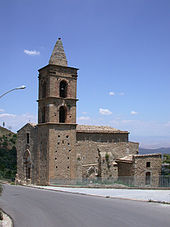Home - In and around
THE CHURCH OF SANT'ANTONIO ABATE AIDONE
is placed at the eastern entrance to the village and traditionally it was originally a small mosque, converted into a Christian church by the Normans: the alleged mosque would be the sixth-long portal in the noon wall, now walled, And the small slots on its sides.
The lateral buttresses that enclose large walled openings make it think of a Greek-style building, perhaps a small Byzantine extra-urban church, or a late-Romanesque building with a three-aisle plant ("clover" ), Which would be a rare example for Sicily.
In the Norman period, however, they belong to the back apse and the portal with a sharp arch, in alternate sandstone and white stones of Comiso. The church has undergone various alterations over the centuries; Of the sixteenth or seventeenth century is the two-order bell tower with single-faces, surmounted by a cusp covered with polychrome spherical elements of Moorish taste.
A mosaic floor, representing St. George who kills the dragon, and numerous furnishings have long been stolen from theft, but there is a fresco of 1581, brought to light by the last restorations, representing the life and temptations of Sant ' Antonio: the central panel representing the Saint is accompanied by eight boxes arranged on both sides, where in a "comic strip" style are episodes of his life depicted by Sicilian captions.
Source wikipedia
The lateral buttresses that enclose large walled openings make it think of a Greek-style building, perhaps a small Byzantine extra-urban church, or a late-Romanesque building with a three-aisle plant ("clover" ), Which would be a rare example for Sicily.
In the Norman period, however, they belong to the back apse and the portal with a sharp arch, in alternate sandstone and white stones of Comiso. The church has undergone various alterations over the centuries; Of the sixteenth or seventeenth century is the two-order bell tower with single-faces, surmounted by a cusp covered with polychrome spherical elements of Moorish taste.
A mosaic floor, representing St. George who kills the dragon, and numerous furnishings have long been stolen from theft, but there is a fresco of 1581, brought to light by the last restorations, representing the life and temptations of Sant ' Antonio: the central panel representing the Saint is accompanied by eight boxes arranged on both sides, where in a "comic strip" style are episodes of his life depicted by Sicilian captions.
Source wikipedia



